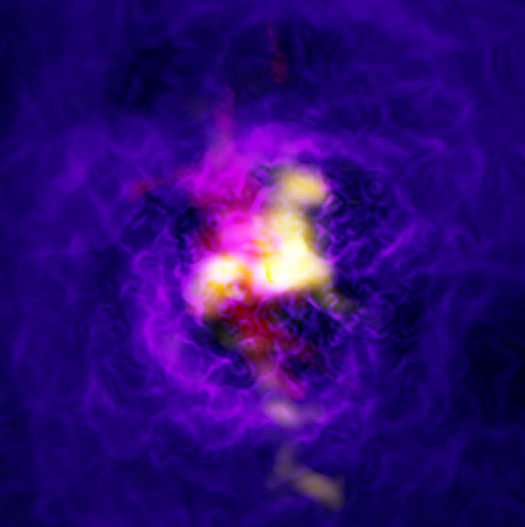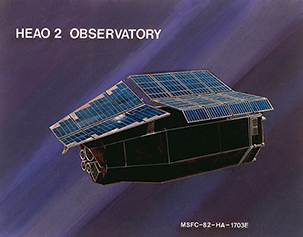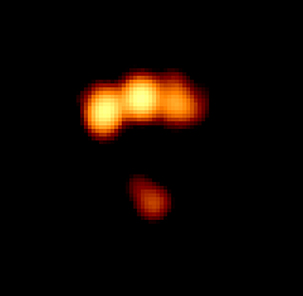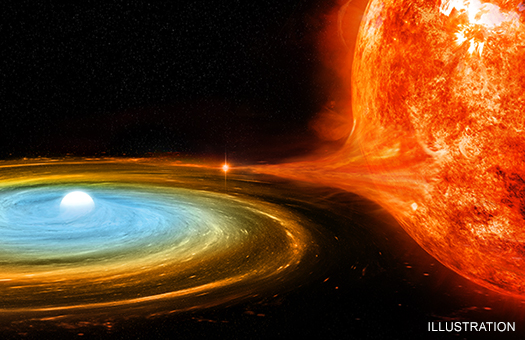Chandra Serves up Cosmic Holiday Assortment
This is the season of celebrating, and the Chandra X-ray Center has prepared a platter of cosmic treats from NASA's Chandra X-ray Observatory to enjoy. This selection represents different types of objects — ranging from relatively nearby exploded stars to extremely distant and massive clusters of galaxies — that emit X-rays detected by Chandra. Each image in this collection blends Chandra data with other telescopes, creating a colorful medley of light from our Universe.
A Hero of the Heroic Age of Astronomy
Riccardo Giacconi (1931-2018)
Riccardo Giacconi, the "Father of X-ray Astronomy," Nobel prize-winner, and one of the most influential figures of modern astrophysics, has died at the age of 87.
Giacconi was born in Genoa Italy on October 6, 1931. He spent most of his life until 1956 in Milan, where he obtained a Ph.D. in physics from the University of Milan, working under the direction of noted cosmic ray physicist Giuseppe Ochialini. Giacconi subsequently worked as an assistant professor at the University of Milan before emigrating to the United States to work for R.W. Thompson as a Fulbright Fellow at Indiana University.
From Indiana he moved to Princeton where he met and worked with Herbert Gursky, also a post-doctoral fellow. According to Giacconi, "We built equipment, worked like fiends, analyzed data, and declared failure." When his Fulbright fellowship expired, Giacconi moved to American Science and Engineering (AS&E) in Cambridge, MA, a startup formed by Martin Annis, an ex-student of Bruno Rossi of the Massachusetts Institute of Technology (MIT). At that time AS&E was primarily involved in military space research.
Remembering Riccardo Giacconi, X-Ray Astronomy Pioneer
Courtesy of NASA.gov

Riccardo Giacconi (Credit: R.K. Morris)
NASA is saddened to note the passing of Riccardo Giacconi, who had a long and illustrious career with the agency.
“Riccardo set the standard for the way that NASA astrophysics is done, by involving the entire astronomy community in space missions via robust Guest Observer programs. We continue to benefit from his foresight,” said Paul Hertz, Director of Astrophysics at NASA.
Giacconi’s early sounding rocket work opened the field of X-ray astronomy, in which NASA continues to be a world leader. He led the sounding rocket experiment that discovered the first two non-solar cosmic X-ray sources: the X-ray background and the neutron star Scorpius X-1. This breakthrough led Giacconi to propose to NASA the Small Astronomy Satellite-A or SAS-A, renamed “Uhuru” at launch. The satellite produced the first catalog of cosmic X-ray sources.
He went on to develop the first focusing X-ray telescope, the Einstein Observatory, and then to write the proposal for NASA's Chandra X-ray Observatory. Chandra continues to operate today, and is the most sensitive X-ray observatory ever developed.
Cosmic Fountain Powered by Giant Black Hole

Abell 2597
Credit: X-ray: NASA/CXC/SAO/G. Tremblay et al; Radio:ALMA: ESO/NAOJ/NRAO/G.Tremblay et al, NRAO/AUI/NSF/B.Saxton; Optical: ESO/VLT
Before electrical power became available, water fountains worked by relying on gravity to channel water from a higher elevation to a lower one. This water could then be redirected to shoot out of the fountain and create a centerpiece for people to admire.
In space, awesome gaseous fountains have been discovered in the centers of galaxy clusters. One such fountain is in the cluster Abell 2597. There, vast amounts of gas fall toward a supermassive black hole, where a combination of gravitational and electromagnetic forces sprays most of the gas away from the black hole in an ongoing cycle lasting tens of millions of years.
Scientists used data from the Atacama Large Millimeter/submillimeter Array (ALMA), the Multi-Unit Spectroscopic Explorer (MUSE) on ESO's Very Large Telescope (VLT) and NASA's Chandra X-ray Observatory to find the first clear evidence for the simultaneous inward and outward flow of gas being driven by a supermassive black hole.
To Boldly Go into Colliding Galaxy Clusters

Credit: X-ray: NASA/CXC/Leiden Univ./F. de Gasperin et al;
Optical: SDSS; Radio: LOFAR/ASTRON, NCRA/TIFR/GMRT

USS Enterprise NCC 1701
Credit: Smithsonian National
Air & Space Museum
Hidden in a distant galaxy cluster collision are wisps of gas resembling the starship Enterprise — an iconic spaceship from the "Star Trek" franchise.
Galaxy clusters — cosmic structures containing hundreds or even thousands of galaxies — are the largest objects in the Universe held together by gravity. Multi-million-degree gas fills the space in between the individual galaxies. The mass of the hot gas is about six times greater than that of all the galaxies combined. This superheated gas is invisible to optical telescopes, but shines brightly in X-rays, so an X-ray telescope like NASA's Chandra X-ray Observatory is required to study it.
Happy 40th Birthday, Einstein Observatory

Einstein Observatory/HEAO 2
On November 13, 1978, the High Energy Astrophysical Observatory 2 (HEAO-2) blasted into space from Cape Canaveral, Florida. Renamed the Einstein Observatory after it was successfully placed into orbit, this was the first fully imaging telescope dedicated to looking at X-rays beyond the Sun.
The Einstein Observatory and the Smithsonian Astrophysical Observatory (SAO), part of the Harvard-Smithsonian Center for Astrophysics in Cambridge, Mass., are forever linked. The telescope was conceived, proposed to NASA, run by, and its data processed by SAO. The original conception for Einstein came from a group at the American Science & Engineering company, led by Nobel Prize-winner Riccardo Giacconi, which moved to SAO in 1973. SAO’s Leon van Speybroeck, who would later become the Telescope Scientist for Chandra, designed the telescope for Einstein.
In addition to being the first X-ray telescope capable of making images, Einstein was an extremely important mission for other reasons. For example, the Einstein Observatory set aside about a quarter of its observing time for a “Guest Observer” program. SAO’s Fred Seward headed the Guest Observer program and ensured an open, competitive process that enabled scientists who were not part of the original consortium to propose observations and to analyze Einstein data.
Playing it Safe: Chandra's Return to Science Observations

Credit: NASA/CXC/Trinity University/D. Pooley et al.
On October 10th, NASA’s Chandra X-ray Observatory went into “safe mode,” following a glitch on one of the telescope’s gyroscopes. After hard work by the team at the Chandra X-ray Center, the problem was identified and solved, allowed Chandra to resume science observations less than two weeks later on October 21st.
One of the first targets that Chandra looked at after its return to science was PS 0147+4630, a gravitationally-lensed quasar. What is that exactly? A quasar is a supermassive black hole that is rapidly consuming gas from its surroundings. The gas falls into a disk around the black hole where it becomes hot and generates prodigious amounts of radiation. Gravitational lensing is a phenomenon, first predicted by Einstein, where light from a very distant source is bent by a massive intervening object, such as a large galaxy or a galaxy cluster. This creates multiple images of a single, faraway object and amplifies the brightness of the light, acting in some ways as a natural magnifying glass.
Skeletons and Spacecraft: An X-ray Halloween

It’s that excellent time of year again when skeletons become all the rage. With Halloween just around the corner, the good folks at the Oregon Zoo released a series of X-ray images that show the fascinating — and a little bit spooky — skeletons of some of their animals.
Those of us who work for NASA’s Chandra X-ray Observatory share an affinity for X-ray images. After all, we’ve been in the business of collecting X-rays from space for nearly 20 years. During that time, we’ve observed X-rays coming from material falling into black holes, the remains of exploded stars, galaxies, and much, much more.
What’s the connection between X-rays from a doctor’s (or vet’s office) and those of a space-based telescope? A medical X-ray machine consists of two parts: an X-ray source at one end, and a camera at the other. The body or body part is placed in between. When the X-rays from the source shine, the camera records the X-rays that reach the photographic film or detector.
Carnival of Space
The Carnival of Space is a round up of astronomy and space-related blogs that started back in 2007. Every week, a different webmaster or blogger hosts the carnival, showcasing articles written on the topic of space. This week, it's our turn to host the Carnival here on the Chandra blog. Enjoy!
There’s a lot of news happening out there on the ground so let’s make sure we keep an eye on the latest from space in this week’s Carnival of Space.
At Universe Today, there were a slew of good posts to consider:

Artist’s impression of SpaceX’s proposed Mars Base Alpha. Credit: SpaceX
Author Matt Williams discusses how his experience as a science journalist helped become a better science fiction writer. https://www.universetoday.com/140285/how-science-journalism-helped-me-b…
Tammy Plotner takes us on a tour of the globular cluster NGC 6681, a.k.a. Messier 70, in their series of Messier Monday. https://www.universetoday.com/37776/messier-70-1/
A report on the recent acquisition of a Danish freighter by Blue Origins updates us on the latest from the race to affordability by private space companies: https://www.universetoday.com/140375/blue-origin-will-be-landing-its-ro…



